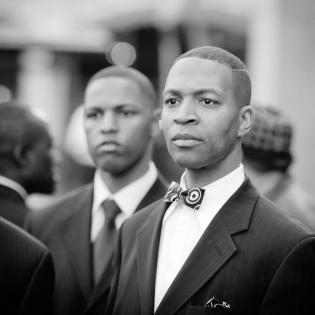A Forum on Racism
In this lesson, young people compare the communications and strategies of Malcolm X with those of Martin Luther King, Jr. They discuss the causes, effects, and ways to address racism through a discussion forum. They plan and hold the forum in the community.
The learner will:
- read a variety of authors on the history and impact of racism and the way forward.
- organize and sponsor a forum on racism.
- service: to provide a community or organization with something that it needs
- prejudice: a preformed opinion, usually an unfavorable one, based on insufficient knowledge, irrational feelings, or inaccurate stereotypes
- advocacy: active verbal support for a cause or position
- nonviolence: the principle of refraining from using violence, especially as a means of protest
- privilege: a right, immunity, benefit, or exemption enjoyed only by a person or persons beyond the advantages of most
These Learning to Give activities build Cultural Competence and SEL for Social Justice
Instructions
Anticipatory Set:
Talk about the ways we communicate, such as through the arts and writing as well as with our body language, facial expressions, implied messages, and direct communication, among other ways. Ask which type of communication is most clear and effective (answers may vary). Ask what topics are difficult to talk about, and people avoid direct communication in those areas. Some of those areas may be cancer, body functions, death, family relationships, race, and religion.
Sometimes conflict can be avoided or resolved when difficult topics are addressed directly. Someone who facilitates a difficult discussion is acting for the common good and sharing a talent for communication and problem-solving.
Introduce the idea of holding a forum on racism. A forum is public meeting for open discussion of various topics where users can interact with questions and discussions on a given topic. The youth may invite experts to speak at a forum on the topic of racism and provide tools and awareness of how to have critical conversations. The goal is to directly communicate about and discuss racism in its many forms, from institutional racism to privilege. Through their efforts, they may bring enlightenment to some and impact policy changes. One person can make a difference through service, and service takes many forms, including education and social activism.
Youth may read a variety of texts and discuss the history and impact of racism and the way forward in today's culture. The following resources provide a starting point:
- Stamped: Racism, Antiracism, and You by Ibram X Kendi and Jason Reynolds
- A Simple Question: Do Black Lives Matter? video
- 75 Things White People Can Do for Racial Justice article
- Institutionalized Racism: A Syllabus
- Anti-Racism for Kids: An Age-by-Age Guide to Fighting Hate
- Deconstructing White Privilege with Dr. Rob DiAngelo video
Young people may invite speakers from local organizations to sit on a panel of experts and share their expertise at the public forum. Be inclusive and invite people from a variety of backgrounds, professions, and community groups. Suggestions include: educators, students, law enforcement, nonprofit representatives, religious leaders, human rights organizations, civic groups, elected officials, and journalists.
- A forum needs a moderator. Be sure your moderator is articulate and has knowledge of the subject (news personalities, elected officials, educators, or clergy).
- Nonprofit organizations may promote the event by posting it in their newsletters or by creating and posting flyers and posters.
- Young people can promote their forum with posters, flyers, and social media.
- Invite reporters to cover the event so that it reaches even more people than those who attend.
Reflection: After the forum, discuss why doing this project was important for the common good.
Philanthropy Framework
-
Strand PHIL.I Definitions of Philanthropy
-
Standard DP 01. Define Philanthropy
-
Benchmark HS.1 Define philanthropy to include giving and sharing; volunteering; and private individual action intended for the common good. Explain how a volunteer individual/group can act for the common good.
-
-
-
Strand PHIL.II Philanthropy and Civil Society
-
Standard PCS 03. Philanthropy and Economics
-
Benchmark HS.9 Analyze a major social issue as a "commons problem" and suggest ways the civil society sector could help to resolve it.
-
-
Standard PCS 05. Philanthropy and Government
-
Benchmark HS.10 Discuss the results of private citizen voluntary action intended for the common good on public policy changes.
-
Benchmark HS.12 Explain why private action is important to the protection of minority voices.
-
Benchmark HS.14 Give examples of how citizens have used organizations in the civil society sector to hold people in power accountable for their actions on behalf of the public.
-
-
Standard PCS 06. Philanthropy in History
-
Benchmark HS.1 Describe how the common good was served in an historical event as a result of action by a civil society sector organization.
-
-
Standard PCS 07. Skills of Civic Engagement
-
Benchmark HS.1 Utilize the persuasive power of written or oral communication as an instrument of change in the community, nation or the world.
-
Benchmark HS.3 Participate in acts of democratic citizenship in the community, state or nation, such as petitioning authority, advocating, voting, group problem solving, mock trials or classroom governance and elections.
-
-
-
Strand PHIL.III Philanthropy and the Individual
-
Standard PI 01. Reasons for Individual Philanthropy
-
Benchmark HS.4 Cite historical examples of citizen actions that affected the common good.
-
-
-
Strand PHIL.IV Volunteering and Service
-
Standard VS 03. Providing Service
-
Benchmark HS.1 Provide a needed service.
-
Benchmark HS.2 Describe the goals of the project and their impact.
-
Benchmark HS.3 Describe the task and the student role.
-
-
Standard VS 05. Integrating the Service Experience into Learning
-
Benchmark HS.2 Evaluate progress on the service-learning project before, during, and after the project.
-
-
